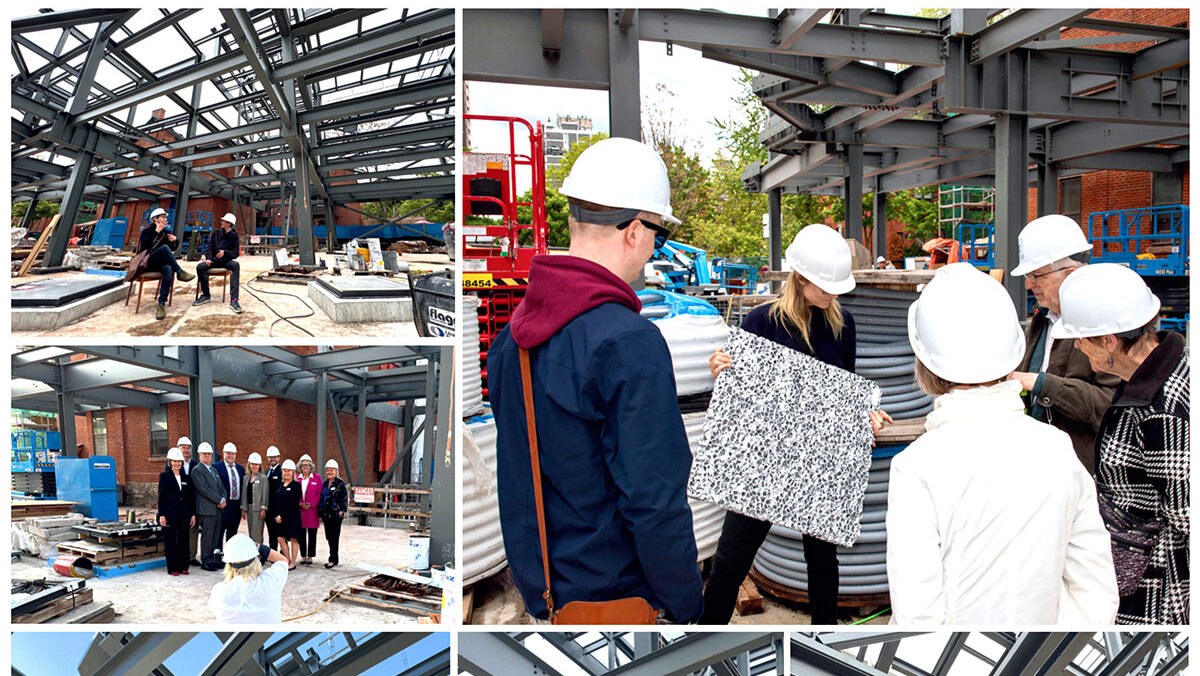The Estonian House is a 38,540 sf. building on 43,560 sf. (.99 acres) of land. The building was constructed in 3 phases, starting with the Chester Schoolhouse built in 1890. The Chester Schoolhouse was built to existing commercial building code standards at that time. Phase 2 consisted of the Great Hall built in 1963 situated on the backside of the Chester Schoolhouse. Phase 3 was the front facing four storey addition built in 1975. All were built to Ontario Building Code standards.
Structural Review:
The structural review included examination of:
a) The Great Hall floor, laminated posts and beams, floor structure and basement walls/foundations where visible.
b) The Chester School building foundations, basement, floors, exterior walls and some exposed wood beams.
Observations:
All items reviewed were found to be fundamentally in good, safe and sound condition and are likely to remain that way for a long time. Some water damage was noticed to a few roof beams under the flat roof portion of the Great Hall roof, however, they do not pose any structural concerns.
The front facing addition was not reviewed because it is considered a relatively new building in good condition.
Mechanical (heating & cooling) and Electrical Review:
The two hot water boilers and one steam boiler, distribution pipes and controls, sewer lines.
Observations:
The two hot water boilers have 50% extra capacity which could be redistributed elsewhere within the building with adjustments to some of the pipes. The steam boiler is in working condition, but, is surplus to the needs and could be retired after some adjustments to the circulation pipes.
The pipe joints were covered properly and taped. There was no visible asbestos observed around the pipes. There was no asbestos observed in the walls. It is possible that asbestos is in some of the floor tiles in the Chester Hill section of the Estonian House which can be easily removed following proper removal procedures.
All mechanical items are in working condition and likely to last for many years. Eventually, adjustments can be made to renew some of the old equipment to economize operations. Ambient censors and modulating temperature controls for the steam boiler are recommended if boiler remains in operation.
The sewer lines would require a camera review to ensure that they are in proper functioning condition.
Roof top A/C units Review:
The A/C units above the Great Hall roof are in satisfactory working condition.
Electrical Review:
The electrical room including metering and power distribution.
Observations:
Specific review of the main electrical room including metering and power distribution found all to be in working condition.
Eventually meters and some wiring will need to be revised and updated to economize use. Wireless programmable thermostats should be provided for electric baseboard heaters to economize use.
Architectural Review:
Exterior and Interior building observations:
The roof of the Great Hall and main lobby area require new suitable roofing properly sloped to create positive drainage. Flashings on the roof and walls need to be properly fixed and installed. The exterior walls of the old schoolhouse require replacement of bricks in some areas for visual attractiveness. Fire doors and alarms need to be reviewed and adjusted. Maintenance manuals and repair logs are not kept and daily energy controls manuals and repair logs need to be implemented and properly maintained.
All of these issues can be corrected and updated in a phased-in work schedule without effecting tenants and the operation of the facility.
The general design and layout of the buildings:
The Estonian House has great appeal as a neighbourhood iconic community centre, as an important heritage site housing the Chester Hill Schoolhouse, and its reputation as a great affordable rental facility with ample parking, multiple halls, kitchen’s and inviting open lobbies. It has many nearby transportation options including easy access to the subway and bus routes, DVP and to the downtown corridor. The Great Hall back addition, Chester Hill section and the 4 storey front addition offer charming, historic, architecturally iconic and varied space experiences. Circulation and common areas, such as, hallways, stairwells, lobbies, washrooms, elevators, etc. are well and conservatively laid out for a community center use, which requires more circulation space than an office building. The Estonian House overall space and layout is efficient for its intended use as a community center.
With proper maintenance, management and scheduled major capital repairs, such as, the roof, (a grant was submitted to the provincial government) the Estonian House operating and maintenance costs can be stabilized. A direct link between the front facing Broadview lobby and the side main lobby through the Crystal Hall can be designed and constructed economically for improved accessibility.
The existing ground level Estonian House office and Estore facing Broadview Avenue could be renovated and enlarged into a new Café, increasing the sustainable revenue that the Estonian House requires.
A long term revenue generating option would be to build an addition above the Great Hall. A six storey rental office space including a roof top restaurant overlooking the beautiful views of the park and city could generate a robust return on the investment and maintain the Estonian House as a viable and sustainable enterprise and community centre.
Summary:
We are of the opinion, in our respective areas of expertise, that, the Estonian House building condition as observed is fundamentally good, safe and sound and it is not in any critical condition. Maintenance and repair manuals, logs and inspections, which were not previously available, should be carried out regularly. Any of the deficiencies noted can be effectively and economically corrected without being prohibitive by a phased and scheduled system that would not disturb the day-to-day operations of the Estonian House.
Contrary to the Estonian House Board, staying at the Estonian House is a sound and viable option for the community.
Lembit Maimets, Structural Engineer
Toomas Saar, Mechanical Engineer
Guido Laikve, Architect (Ret)




